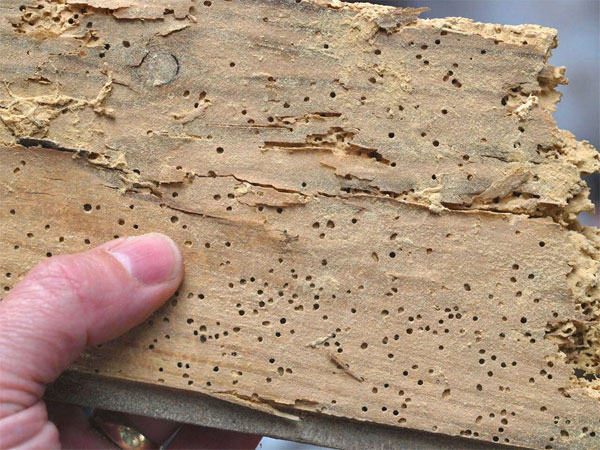Woodworm in buildings
Contents |
[edit] Introduction
Woodworm infestation of untreated timber is a relatively common problem. The House Longhorn beetle was a particular problem in the UK prior to the introduction of pretreated timber in the 1960s.
The House Longhorn beetle measures up to 25 mm long when mature, and can lay up to 200 eggs on the rough surface of untreated timber. After 2-3 weeks, the larvae emerge and bore into the timber. They can be detected by the powdery deposits known as ‘frass’ left on the surface and the bore holes of around 3 mm diameter. They are attracted to damp areas and timber with a high moisture content.
If you’ve only just noticed these holes, it’s unlikely that the structural integrity of the beam has been compromised. If you’ve only just revealed the beam, for example it was under plasterboard or a thick coat of varnish, it’s important to get the timber inspected by an expert as soon as possible, who will be able to identify the type and extent of any infestation you may have, and also let you know whether there are any structural issues to consider.
Other woodborer insects include:
- Furniture beetle: These are 6-8 mm long and lay 20-50 eggs on soft or hardwoods.
- Lyctus powder post beetle: These are 10-15 mm long and lap 70-200 eggs on the sapwood of new hardwood.
- Death Watch beetle: Around 7 mm long and lay 40-80 eggs on hardwood. Are a particular problem on oak timbers found in old churches and similar buildings.
[edit] Is the infestation active or inactive?
It is important to identify whether and infestation is active or inactive. Very often, tunnels and holes found in decorative beams in your home are of historical nature and the beam was left in place as the previous attack did not affect the structural integrity of the beam.
Nevertheless, it is important to identify whether the holes you have found are due to a currently active woodworm. Sometimes you may be able to see frass. This is a dust-like or gritty substance that that comes out of the holes during emergence season – normally around May to September. Occasionally you may even see the beetle. If you are lucky enough to see a beetle, try to keep it in a container until you bring in a specialist as it will help with the identification, and therefore treatment, of your wood boring insect.
If you’re not sure if the frass is fresh and you have not seen any beetles emerging, there are a couple of things to try. You could fill the holes with shoe polish and await the emergence season. If the infestation is active, you will see the shoe polish is no longer in place. Alternatively, you could wrap some newspaper around the beam, again wait for the emergence season and then check the paper for frass.
[edit] What steps are required to successfully treat a timber infestation?
The process for treating timber is a specialist task which includes:
- Correct identification of the infestation and its extent through looking at identifying factors such as the tunnels, the emergence holes and the frass.
- Ensure all timbers can be accessed.
- Check extent of damage by probing and drilling if required, for example treatment of Death Watch Beetle (Xestobium rufovillosum).
- Thorough cleaning down of all timbers to ensure the timber, not the frass, is treated.
- Expose built in ends of structural timbers.
- Correct and thorough application of species-specific insecticides.
- Utilising health and safety best practice for your re-entry time.
Timber can be treated:by:
- A water-based boron treatment which can be sprayed or brushed on, or injected as a gel or paste.
- Ultraviolet insect killers.
- Fumigation or fogging.
- Replacing affected wood.
- Monitoring and improving conditions to prevent re-infestation.
A specialist survey may be necessary to determine the most appropriate form of treatment.
For more information, see also: Timber preservation and Woodworm and spiders.
[edit] Will the problem return?
Depending on the infestation type, you may see some symptoms in the coming years due to the life cycle of the beetle and the fact that the insecticide used is a contact insecticide. This means that for treatment to be effective the life cycle must be completed as only emerging beetles or lava laid on the surface of treated timbers will be destroyed. Despite of this life cycle, which differs depending on breed, rest assured. All our timber treatments come with long term guarantees for your peace of mind.
See also: Common furniture beetle.
[edit] Related articles on Designing Buildings
- Ancient Woodland.
- Building preservation archive.
- Common furniture beetle.
- Death watch beetle.
- Defects in construction.
- Domestic roofs.
- Dry rot fungus.
- European Union Timber Regulation.
- Forests.
- Insects.
- Powder post beetle.
- Recognising wood rot and insect damage in buildings.
- Roofing defects.
- Timber.
- Timber framed buildings and fire.
- Timber preservation.
- Wood-boring weevil.
- Woodworm and spiders.
--AtlantisDamp 12:41, 20 Mar 2019 (BST)
IHBC NewsBlog
Old Sarum fire in listed (& disputed) WW1 Hangar - Wiltshire Council has sought legal advice after fire engulfed a listed First World War hangar that was embroiled in a lengthy planning dispute.
UK Antarctic Heritage Trust launches ‘Virtual Visit’ website area
The Trust calls on people to 'Immerse yourself in our heritage – Making Antarctica Accessible'
Southend Council pledge to force Kursaal owners to maintain building
The Council has pledged to use ‘every tool in the toolbox’ if urgent repairs are not carried out.
HE’s Research Magazine publishes a major study of the heritage of England’s suburbs
The article traces the long evolution of an internal programme to research 200 years of suburban growth
IHBC Context 183 Wellbeing and Heritage published
The issue explores issues at the intersection of heritage and wellbeing.
SAVE celebrates 50 years of campaigning 1975-2025
SAVE Britain’s Heritage has announced events across the country to celebrate bringing new life to remarkable buildings.
IHBC Annual School 2025 - Shrewsbury 12-14 June
Themed Heritage in Context – Value: Plan: Change, join in-person or online.
200th Anniversary Celebration of the Modern Railway Planned
The Stockton & Darlington Railway opened on September 27, 1825.
Competence Framework Launched for Sustainability in the Built Environment
The Construction Industry Council (CIC) and the Edge have jointly published the framework.
Historic England Launches Wellbeing Strategy for Heritage
Whether through visiting, volunteering, learning or creative practice, engaging with heritage can strengthen confidence, resilience, hope and social connections.















